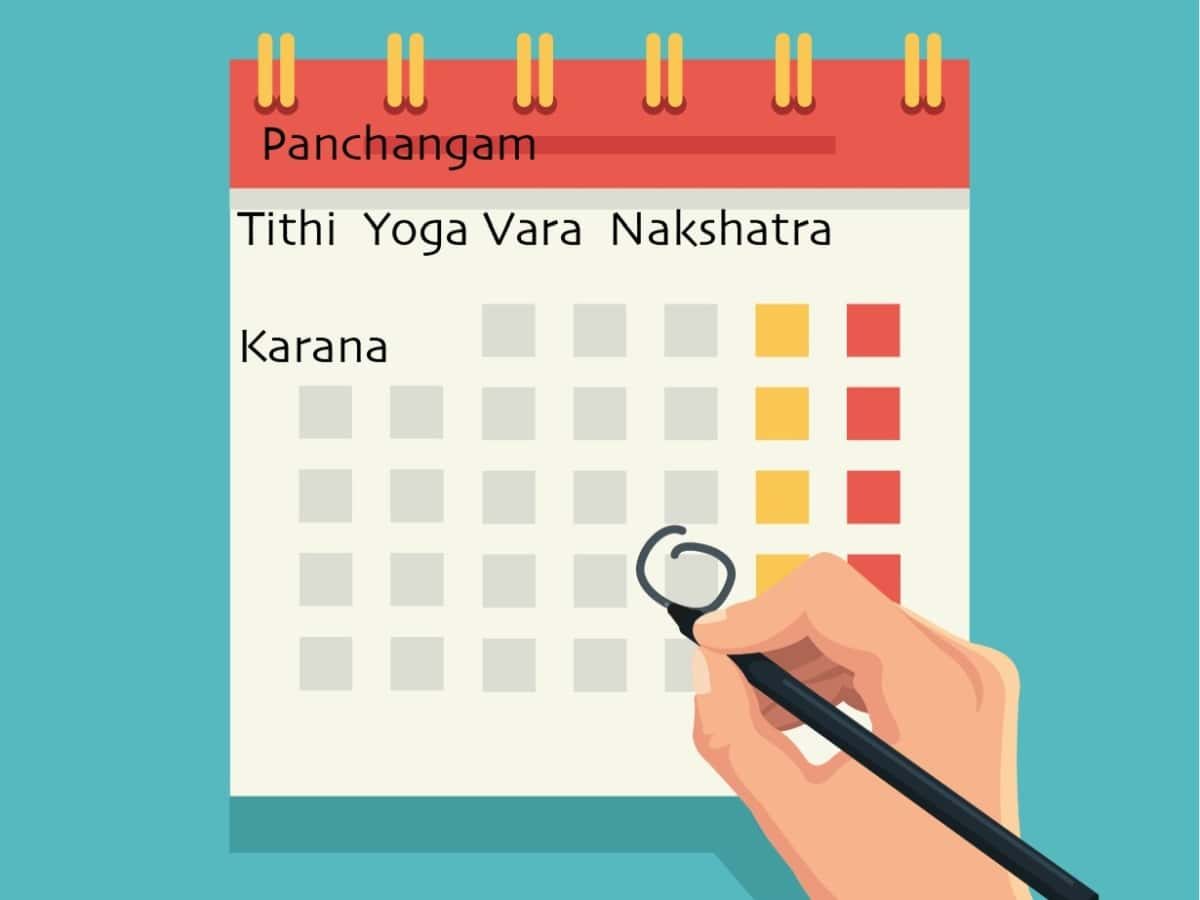Panchangam
The path to understanding Vedic astrology begins with the panchangam and its application. Panchangam is the daily Vedic calendar. Pancha means five, and anga means limbs. So the daily calendar has five elements.
All the five components of the daily calendar are calculated at sunrise and are applied for all auspicious activities of the day.
Here are the five components of the daily calendar.
1.Nakshatra : Nakshatra or the star of the day. There are 27 stars, and the moon moves at a speed of one star per day approximately. The star on which the moon is present at sunrise is calculated as the star or the nakshatra of the day. The nakshatra is used as a benchmark used by everyone to figure if this day is good or bad for a particular person. Everyone has a birth nakshatra or star. When we compare our birth star to the star of the day, it either gives a good, bad result. We will explain this calculation in another article in detail. Here are the names of the 27 stars or nakshatras
1.Ashwini
2.Bharani
3.Krittika
4.Rohini
5.Mrigashira
6.Aardra
7.Punarvasu
8.Pushya
9.Aashlesha
10.Magha
11.Purva Phalguni
12.Uttara Phalguni
13.Hasta
14.Chitra
15.Swati
16.Vishaka
17.Anuradha
18.Jyestha
19.Moola
20.Poorvashada
21.Uttarashada
22.Shravana
23.Dhanishtha
24.Shatabhisha
25.Purva Bhadra
26.Uttarabhadra
27.Revati
Vara: Vara is the day of the week. There are seven days in a week. These varas are again crucial for all our activities. Jupiter and venus are considered benefics. Therefore Thursday, which represents Jupiter and Friday representing venus, is deemed auspicious for any suitable activities. One never gets married or starts any new venture on a Saturday as Saturn is considered to be slow. Sunday is also not very good for auspicious activities. Monday and Wednesday are partially good. So in this way, specific actions are right on certain days and not on certain days. The Sun planet lords Sunday. Moon Lords Monday. Mars Lords Tuesday. Mercury lords Wednesday. Jupiter lords Thursday. Venus Lords Friday. Saturn Lords Saturday. We will deal with each of these days in detail later. In this article, we are introducing these five elements.
Tithi: Tithi is the day of the month. There are 30 tithis in a month. A month in the Vedic calendar begins either on a full moon or a new moon day. From that day to either the full moon or new moon (based on where you start from) is 15 tithis. And from there to either full moon or new moon is again 15 tithis. Now, remember that these 30 tithis may or may not correspond to 30 days. It will be for approximately 28 days. So what is a tithi? Tithi is measured as the angular distance between the sun and the moon. When the sun and the moon are 12 degrees apart, then it is one tithi. Since the zodiac is elliptical, the moon sometimes moves fast and sometimes moves slow. So some tithis are shorter and some longer. The tithi that is prevalent at sunrise is taken as the tithi for the day. Tithis usually change during the day of the day, but for all the purposes of puja(religious activities), the tithi at sunrise is essential. Some tithis are suitable for spiritual activities, some are good for material activities, and some are not good. The tithis are divided into five categories. All these details we will look at in an exclusive article on tithis.
Here are the tithis
1.Pratipada (1st day, after the full moon or new moon)
2.Dwitiya
3.Tritiya
4.Chaturthi
5.Panchami
6.Shashthi
7.Saptami
8.Ashtami
9.Navami
10.Dashami
11.Ekadasi
12.Dwadashi
13.Trayodashi
14.Chaturdashi
15.Purnima
The full moon is called Poornima, and the day after the full moon is called pratipat(1st day), Dwitiya (2nd day), and so on, as given in the above table; This is called 15 days of Krishna paksha or waning moon. Similarly, after the new moon or Amavasya, the days are counted in the above manner, with the same terminology, starting from Pratipada till Chaturdashi and is called Shukla paksha or waxing moon (15 lunar days)
Yoga: There are 27 stars and 27 yogas. Yoga is any benefic state or auspicious time that exists at a given point in time.
Yoga is determined by the total of the positions of Sun and Moon. Each yoga is represented by 13° 20′ degrees (A circle of 360 degrees divided by 27 units gives 13° 20′ per unit). Therefore, the total of Moon and Sun’s angular positions is counted in intervals 13° 20′ degrees to arrive at the yoga. [Whenever the total exceeds 360°, 360° is subtracted from the total calculation purpose.
example: Sun 270° + Moon 200° = 470° –360° = 110°]
The names of the 27 yogas are
1) Vishakumbha 2) Preeti 3) Aatyshman 4) Saubhagya 5) Shobana 6) Atiganda 7) Sukarma 8) Dhriti 9) Shoola 10) Ganda 11) Vriddhi 12) Dhruva 13) Vyaghaata 14) Harshana 15) Vajra 16) Siddhi 17) Vyatipaata 18) Variyaana 19) Parigha 20) Shiva 21) Siddha 22) Sadhya 23) Shubha 24) Shukla 25) Brahma 26) Indra 27) Vaidhriti
Some of the Yogas are said to be Not-so-benefic ones. They are Vishkambha, Athiganda, Shoola, Ganda, Vyaghatha, Vajra, Vyathipatha, Parigha, and Vydhruthi.
Karana :
A tithi is divided into two karanas. There are 11 karanas, and they again denote an auspicious time for specific spiritual or material activity. They are: 1) Bala, 2) Baalava 3) Kaulava 4) Taitila 5) Gara 6) Vanija 7) Visti 8) Shakuni 9) Chatushpada 10) Naaga 11) Kinstugna The first 7 of these Karanas are movable (Chara), i.e., it cannot be predetermined as to on which dates, these are going to occur, but the last 4 Karanas are fixed (Sthira), and hence can be predetermined.

